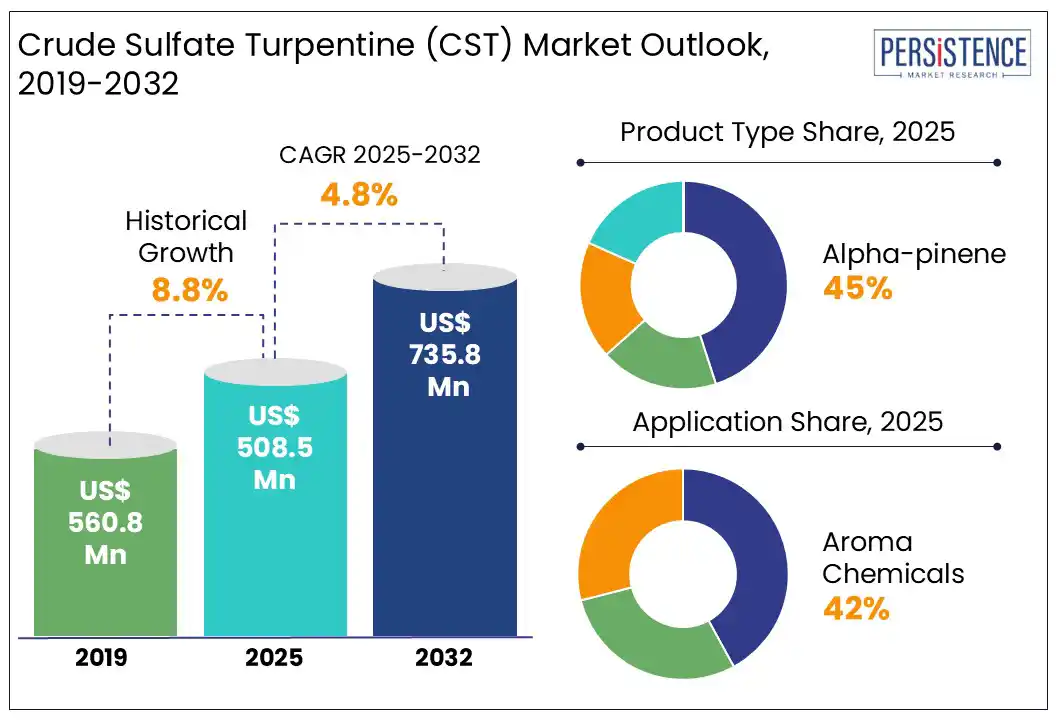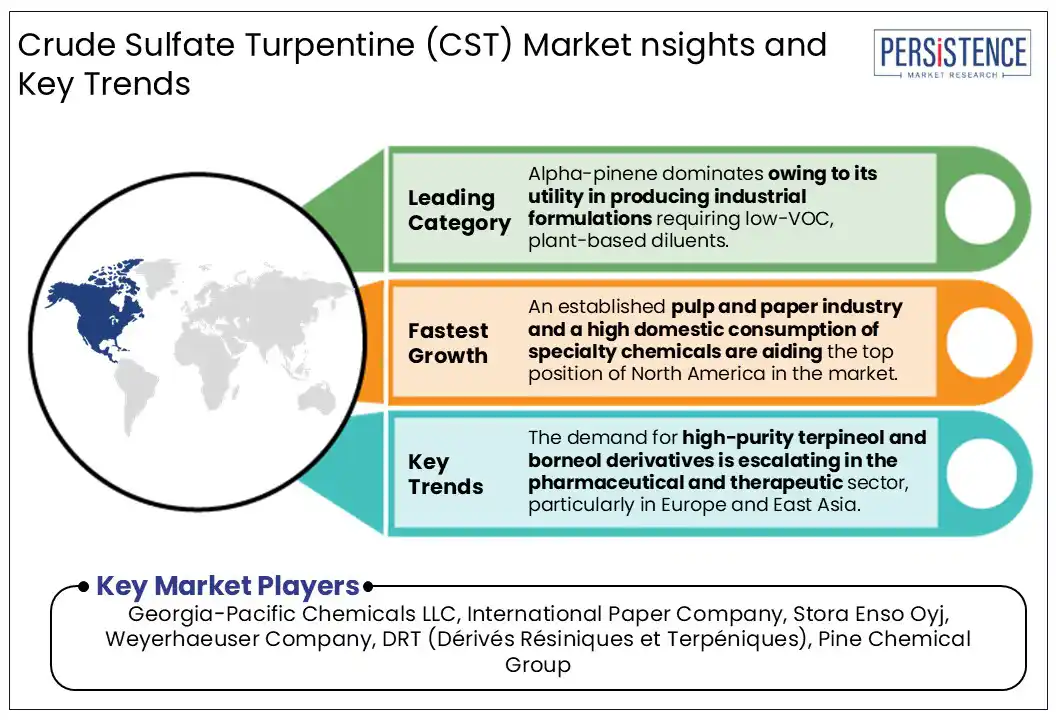ID: PMRREP14488| 200 Pages | 28 Jul 2025 | Format: PDF, Excel, PPT* | Chemicals and Materials

The global crude sulfate turpentine (CST) market size is likely to be valued at US$ 508.5 Mn in 2025, and is estimated to reach US$ 735.8 Mn by 2032, growing at a CAGR of 4.8% during the forecast period 2025−2032. Crude sulfate turpentine (CST) is a bio-based, volatile by-product derived from the kraft pulping process, primarily extracted from pine wood. It is used as a foundational raw material in the production of aroma chemicals, adhesives, solvents, and pharmaceuticals due to its rich terpene content. The crude sulfate turpentine (CST) market is undergoing an excellent growth phase on account of the increasing demand for sustainable and naturally sourced chemicals across the personal care, coatings, and flavor & fragrance industries. As industries pivot toward low-VOC (Volatile Organic Compounds) and renewable alternatives, crude sulfate turpentine is gaining traction not only as a cost-effective petrochemical substitute but also as a value-added input in high-purity derivative applications.

Key Industry Highlights:
| Global Market Attribute |
Key Insights |
|
Crude Sulfate Turpentine Market Size (2025E) |
US$ 508.5 Mn |
|
Market Value Forecast (2032F) |
US$ 735.8 Mn |
|
Projected Growth (CAGR 2025 to 2032) |
4.80% |
|
Historical Market Growth (CAGR 2019 to 2024) |
8.80% |
The global shift toward low-VOC, biodegradable inputs is charting a new growth trajectory for the crude sulfate turpentine (CST) market, particularly in the domains of industrial solvents and specialty chemicals. Crude sulfate turpentine, a by-product of the kraft pulping process, is gaining renewed traction as a bio-based alternative to petrochemical solvents in coatings, adhesives, and cleaning formulations. Regulatory frameworks such as the EU’s REACH and the U.S. TSCA are increasingly restricting the use of hazardous solvents, creating downstream demand for CST-derived green solvents. This shift is further reinforced by ESG commitments, as mandated by the European Chemicals Agency in 2023, in sectors such as packaging, paints, and automotive, where manufacturers are under pressure to decarbonize operations and reduce toxic emissions.
Simultaneously, pulp and paper mills, especially in Scandinavia, Brazil, and Southeast Asia, are attempting to valorize CST through improved recovery and fractionation techniques. What was once discarded as waste is now being monetized through integration with the aroma chemicals, terpene resins, and fine chemicals markets. Companies are scaling up CST fractionation to meet the increasing demand for bio-based pinene derivatives used in flavors, fragrances, and agrochemical intermediates, according to the Global Bio-based Chemicals Market Report, 2024. This evolution in CST processing and application is not only enhancing market liquidity but also creating measurable sustainability-linked value across multiple verticals.
The crude sulfate turpentine (CST) market growth faces a critical structural bottleneck in the form of inconsistent recovery and refining infrastructure across pulp-producing regions. The efficiency and composition of CST extraction vary significantly depending on mill design, wood type, and process parameters. In countries where capital investment in turpentine recovery systems remains limited, particularly in parts of Southeast Asia and Eastern Europe, CST is often burned as fuel, leading to supply deficits in the commercial CST value chain, as reported in a 2021 FAO Forestry Paper.
Moreover, the crude nature of CST makes it inherently variable in quality. The concentration of valuable monoterpenes such as alpha-pinene and beta-pinene can fluctuate widely between batches, complicating downstream applications in fragrance, flavor, and chemical synthesis. This variability hampers CST’s viability as a stable industrial feedstock without costly post-processing or fractionation, subduing its appeal to high-volume buyers seeking consistent input streams. The lack of standardized processing infrastructure across mills further restricts CST’s scalability and adoption in global supply chains, curbing its growth potential even as demand for green chemicals rises.
One of the most promising opportunities in the crude sulfate turpentine (CST) market lies in the extraction and commercialization of high-purity terpene derivatives for use in fine chemicals and pharmaceuticals. CST serves as a renewable source of alpha-pinene and beta-pinene, which are precursors for a wide range of value-added compounds such as camphor, linalool, and geraniol. These derivatives are critical in the production of antiseptics, anti-inflammatory drugs, and aroma chemicals. With the demand for plant-based and sustainable inputs in pharmaceutical formulations and specialty cosmetics soaring globally, terpenes derived from CST prove to be cost-effective, bio-based alternatives to synthetic or petroleum-derived inputs.
The margin potential that this opportunity presents is immense. Unlike traditional applications in low-margin industrial solvents, terpene-based pharmaceutical intermediates and aroma compounds command significantly higher price points, often exceeding US$ 2,000 per metric ton depending on purity and use-case. Companies in Brazil, China, and Finland are investing in precision fractionation and purification technologies to tap into this niche, high-value segment. For instance, Brazilian chemical firms are leveraging the country's abundant pine plantations and advanced pulp mills to develop pharma-grade pinene extracts, positioning CST as a strategic biorefinery input rather than a commodity by-product.
Alpha?pinene dominates the product segment, accounting for about 45% of the revenue share in 2025. Its broad utility spans adhesives, coatings, solvents, and printing inks, particularly in industrial formulations requiring low?VOC, plant?based diluents. Known for its reliability, cost-effective extraction, and compatibility with high-volume applications, producers across the globe are leveraging alpha?pinene as a consistent, scalable feedstock for mass-market products. Furthermore, its role in formulating novel low?odor solvent blends and sustainable coatings is also steadily expanding, pushed by tightening eco-regulations and an urgent demand to green the chemicals industry.
Among individual terpene fractions, beta?pinene stands out, accounting for approximately 29% of CST revenue in 2024. Its superior optical purity (~90–95%) makes it a preferred precursor in stereospecific synthesis, yielding high-value aroma derivatives such as myrcene, linalool, geraniol, and citronellol. The pleasant scent and antimicrobial properties of beta-pinene underpin its rapid uptake in clean-label consumer goods.
Aroma chemicals, covering fragrance, flavor, and essential oil derivatives, commands the largest revenue share of around 42% in the application segment in 2025. Fueled by clean-label and sustainability trends, this niche draws heavily on alpha? and beta?pinene fractions to produce linalool, geraniol, camphor, and limonene, meeting consumer demand in perfumery, personal care, and household cleaning. Green, plant-derived criteria in perfumery and food-grade flavors are widening CST’s value proposition beyond traditional solvent uses.
The solvents & additives segment represents the high-volume industrial base of the crude sulfate turpentine market. CST’s unique terpene chemistry delivers industrial-grade utility by way of superior dissolving power, alignment with renewable systems, and regulatory compliance. Their instrumental role is further reinforced by an integrated demand from the automotive, packaging, and building sectors, which are increasingly shifting toward bio-based formulations.

North America holds a formidable position, holding 39.1% of the market share in 2025. The region’s established pulp and paper industry ensures reliable raw material streams, while major downstream sectors, such as paints and aromatic chemicals, fuel local consumption. Regulatory pressure to reduce VOC emissions in industrial coatings and packaging has heightened the demand for CST as a renewable solvent, with manufacturers integrating CST into eco-friendly adhesive and solvent portfolios. Moreover, the growing trend of health-consciousness in the U.S. and Canada is also driving the employment of natural flavors in foods and beverages, deepening CST’s role in clean-label products with an uptick in organic food sales.
Asia Pacific stands as the fastest-growing region in the crude sulfate turpentine market, clocking a CAGR of around 5.7% through 2032. The surge is primarily from China, India, and South Korea, backed by strong pulp production and favorable policies on sustainable industrialization. Moreover, rapid urbanization and rising disposable incomes in the region, especially in India and China, and highly lucrative automotive and coatings sectors are expanding CST utilization across adhesives, coatings, and bio-solvents.
To tap into this regional market, companies should funnel investments into regional fractionation facilities to produce high-purity terpene derivatives, which are increasingly in demand across specialty chemical applications. Targeting supply chains for high-growth FMCG segments such as personal care and air care can further enhance market penetration. Developing delta-3-carene based resins and solvents tailored to the region’s growing manufacturing sectors, particularly in paints, adhesives, and agrochemicals, can position market players to capitalize on emerging industrial and regulatory trends.
Europe is the second-largest market owing to the soaring demand for natural ingredients in cosmetics and personal care across the U.K., France, and Germany. Industrial coatings and paint sectors are also significant end-users, deploying CST in low-VOC formulations and disinfectants. Europe also leads in refining innovations, producing higher-purity derivatives, such as camphor, borneol, terpineol, and limonene, for fragrance, pharmaceutical, and specialty chemical applications. Stringent environmental regulations on VOCs and chemical safety further broaden the applicability of crude sulfate turpentine. For companies, the opportunity in Europe lies more in value than in volume. Positioning high-purity CST derivatives for premium applications in fine fragrances and pharmaceuticals, where quality and compliance matter most, would be the most profitable route to take.
The global crude sulfate turpentine (CST) market is shaped by the operations of integrated pulp and paper producers and specialized chemical refiners. Firms such as Georgia-Pacific Chemicals, International Paper, Weyerhaeuser, and Stora Enso benefit from internal access to raw CST as a by-product of their kraft pulping activities, enabling them to serve both bulk industrial applications and mid-grade terpene needs.
In contrast, companies such as DRT, Eastman Chemical, and Pine Chemical Group focus on refining crude sulfate turpentine into high-purity derivatives for niche segments such as fragrances, pharmaceuticals, and green solvents. Advanced distillation and purification technologies set these players apart. Eastman, for example, caters to ink and coating industries with high-performance CST-based solvents, while smaller innovators such as Gulf Pine Chemicals are exploring sustainable extraction methods to appeal to environmentally driven manufacturers.
Recent shifts in strategy across the sector include M&A, cross-sector partnerships, and tailored downstream development. For instance, Pine Chemical Group’s acquisition of Georgia-Pacific’s pine chemicals business marked a major consolidation move, significantly expanding its CST refining footprint. Other firms have been partnering with regional distributors in Europe to target the premium aroma and clean-label cosmetic space.
The crude sulfate turpentine (CST) market market is projected to reach US$ 508.5 million in 2025.
The global shift toward low-VOC, biodegradable inputs in the domains of industrial solvents and specialty chemicals is driving the market.
The crude sulfate turpentine (CST) market is poised to witness a CAGR of 4.8% from 2025 to 2032.
The extraction and commercialization of high-purity terpene derivatives for use in fine chemicals and pharmaceuticals is key market opportunity.
Georgia-Pacific Chemicals LLC, International Paper Company, and Stora Enso Oyj are some key players in the market.
|
Report Attribute |
Details |
|
Historical Data/Actuals |
2019 - 2024 |
|
Forecast Period |
2025 - 2032 |
|
Market Analysis |
Value: US$ Mn |
|
Geographical Coverage |
|
|
Segmental Coverage |
|
|
Competitive Analysis |
|
|
Report Highlights |
|
|
Customization and Pricing |
Available upon request |
By Product Type
By Application
By End-use
By Region
Delivery Timelines
For more information on this report and its delivery timelines please get in touch with our sales team.
About Author